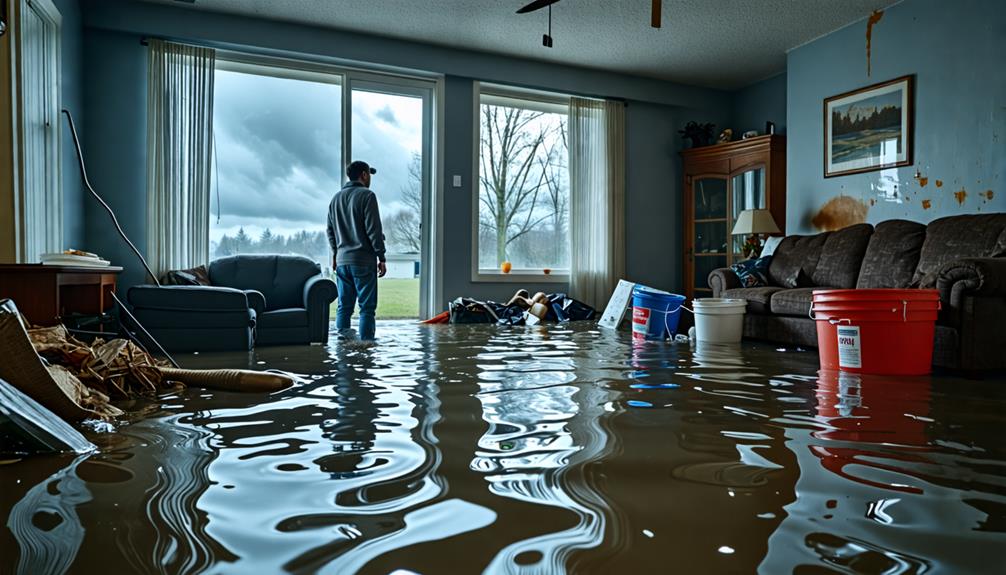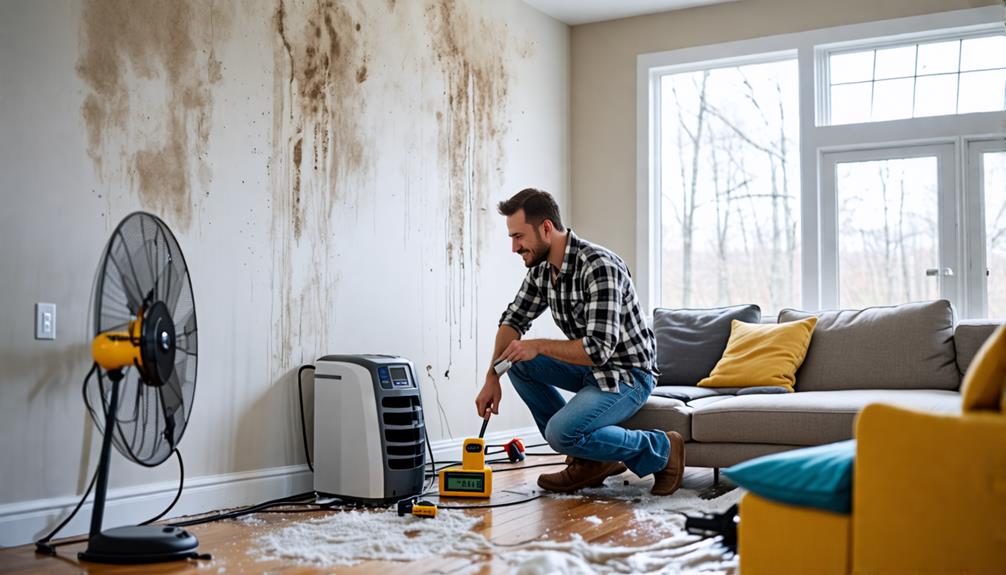After Tropical Storm Debby, it's crucial to check your home for water damage. Look for signs like yellow stains on walls or ceilings, soft spots in drywall, musty odors, or warped floors. Areas like basements and attics are particularly vulnerable. Prioritize your safety by turning off electricity near water. Move valuables to higher ground and document any damage with photos for your insurance. Assess all prone areas and use moisture detection tools for hidden issues. Taking prompt action can prevent further harm, and you'll find more tips and solutions to protect your home effectively ahead.
Key Takeaways
- Look for discoloration, soft spots, and musty odors to identify signs of water damage after Tropical Storm Debby.
- Inspect basements, attics, and ground-level rooms for leaks and moisture infiltration to assess damage.
- Document all water damage with photos for insurance claims and future reference.
- Take immediate action by relocating valuables to higher ground and using tarps to cover leaks.
Signs of Water Damage

After a storm like Tropical Storm Debby, you may notice several signs of water damage in your home. It's important to act quickly, as lingering moisture can lead to mold growth, which poses health risks and can compromise your home's structural integrity.
Start by checking for discoloration on your walls or ceilings. Stains that appear yellow or brown could indicate water pooling behind the surface. You might also feel soft spots in the drywall or wood, signaling that moisture has infiltrated those materials. Pay attention to musty odors, too; they often hint at hidden mold growth.
Inspect your floors for warping or buckling, as this suggests excessive moisture has seeped in. Furthermore, if you spot peeling paint or wallpaper, it's a clear sign that water has affected the underlying materials.
Areas Most Affected
Certain areas of your home are more vulnerable to water damage during storms like Tropical Storm Debby, including basements, attics, and ground-level rooms. If you live in coastal regions, you're likely more susceptible to severe flooding, especially when storm surges combine with heavy rainfall. Urban flooding can worsen the situation, overwhelming drainage systems and causing water to seep into your home.
Basements often bear the brunt of this damage because of their location below ground level. If water levels rise, even slightly, you could face extensive damage. Attics aren't immune either; if your roof leaks or if water accumulates from melting snow or heavy rain, you could see moisture seeping down into living spaces. Ground-level rooms, such as living rooms and kitchens, are likewise at risk, particularly if your property lacks proper drainage or sits in a low-lying area.
Understanding these vulnerable spots in your home can help you prepare and respond better. Remember, being aware of these risks is the first step toward protecting your cherished space from the unfortunate impacts of storms.
Immediate Actions to Take

If you experience water intrusion from Tropical Storm Debby, acting quickly can considerably reduce damage to your home and belongings. Start by guaranteeing safety; turn off electricity if water is near outlets. Contact emergency services if necessary, and reach out to your emergency contacts for support.
Next, focus on temporary repairs to prevent further damage. Use tarps or plastic sheeting to cover leaks and block additional water entry. Move furniture and valuables to higher ground to keep them safe from water exposure. Document everything with photos for insurance purposes.
Here's a quick reference table to guide your immediate actions:
| Action | Description | Importance |
|---|---|---|
| Guarantee Safety | Turn off electricity and check for hazardous conditions | Protects you from injury |
| Contact Emergency Services | Call for help if the situation is severe | Guarantees safety and assistance |
| Begin Temporary Repairs | Use tarps and relocate valuables | Minimizes damage |
Taking these steps right away can make a significant difference in your recovery process. Remember, you're not alone—reach out for help when you need it.
Assessing the Damage
Start by carefully inspecting your home for any signs of water damage, as this will help you understand the extent of the problem and prioritize your recovery efforts. Look for discoloration on walls and ceilings, warped flooring, or peeling paint. These are often telltale signs that moisture has infiltrated your space.
Conduct a thorough damage assessment. Check areas prone to leaks, like basements, attics, and around windows. Pay close attention to carpets and rugs; they can retain moisture and lead to mold growth. If you're uncertain, consider using moisture detection tools to pinpoint hidden water sources. These devices can help you identify dampness behind walls or beneath floors, ensuring you don't miss any vital areas.
As you assess the damage, remember to take notes and photographs. Documenting everything can be essential for insurance claims and future reference. It's understandable to feel overwhelmed, but addressing these issues promptly can prevent further complications down the road. By taking these steps, you're actively working towards restoring your home, making it a safe haven once again.
Long-Term Solutions

To effectively prevent future water damage, consider implementing extensive drainage solutions around your property. This could include installing gutters, downspouts, and drainage ditches that redirect water away from your foundation. Prioritize these long-term solutions to make certain your home remains safe and dry.
| Solution Type | Description | Repair Techniques |
|---|---|---|
| Gutters | Directs rainwater away from the roof | Clean regularly, seal leaks |
| French Drains | Subsurface drainage system | Install gravel and piping |
| Sump Pump | Removes water from basement | Regular maintenance checks |
| Yard Grading | Slope yard away from the home | Adjust soil levels |
| Waterproofing | Protects basement walls | Apply sealants or membranes |
When considering these options, don't forget about insurance considerations. It's essential to check your policy for coverage on water damage repairs. Understanding what's covered can save you from unexpected expenses later on. By taking these proactive steps, you can guarantee that your home stands resilient against future storms, providing you peace of mind.
Preventive Measures for Future Storms
Taking proactive steps now can greatly reduce the impact of future storms on your property. Start with storm preparedness by creating an emergency plan for your family. Discuss evacuation routes, communication strategies, and a designated safe space in your home.
Next, focus on home maintenance. Inspect your roof for loose shingles and seal any gaps around windows and doors to prevent water intrusion. Clean gutters regularly to guarantee proper drainage, and consider installing downspouts that direct water away from your foundation.
Also, think about landscaping. Trim trees and shrubs to reduce the risk of falling branches during storms. Creating a slope away from your home can help keep water from pooling near the foundation.
Conclusion
In the wake of Tropical Storm Debby, don't let your home suffer in silence. By taking swift action and addressing water damage early, you can keep the situation from spiraling out of control. Remember, a stitch in time saves nine! Regularly check for signs of moisture and implement preventive measures to safeguard your home against future storms. Your home deserves your attention, and being proactive now can save you a world of trouble later.
